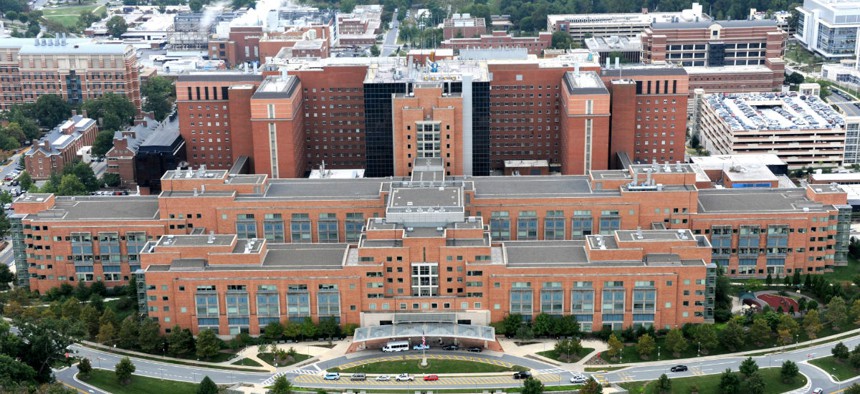
NIH's clinical center on the Bethesda, Md., campus. National Institutes of Health
What's Next for the National Institutes of Health After Its Big Funding Boost?
Congress rallied around the agency this year.
When Americans go to the ballot box, they expect the congressional candidates they support to take their interests to the Hill—to fight for the political issues and programs they prefer with an enthusiasm and dedication that’s deeply personal. That doesn’t always happen. But in the last year or so, members of Congress responded to what one member called a “constituent-driven movement” to rally around the National Institutes of Health and the biomedical research it funds.
Last month, Congress passed a $2 billion increase for the NIH, the biggest funding bump in over a decade, as part of larger spending bill for 2016. “We’re gonna fight over Obamacare, we’re gonna fight over family planning, we’re gonna fight over any number of educational programs,” said the Republican Tom Cole, the chairman of the House Appropriations subcommittee that determines healthcare, labor, and educational funding. But they’re not going to fight over the value of the NIH.
Constituents surely did have influence here; when legislators talk about why they supported more funding for the NIH, they cite the voices of research institutions in their districts, patient advocates, and often patients themselves. But the nonpartisan nature of disease had its effect, too: Biomedical research transcends political divides because everyone, including members of Congress, knows someone affected by conditions NIH researchers investigate. (Cole himself has intimate experience here: His wife has multiple sclerosis, and his dad had Alzheimer’s disease. That experience, he’s said, doesn’t influence his funding preferences.)
Congressional disagreements around the agency tend to be limited to how much funding it deserves, not whether it deserves much at all. And as supporters prepare themselves for new budget negotiations around the corner, they’re hoping this increase—with money for Alzheimer’s, precision medicine, and other research—is the first of many to come.
Historically, the NIH, the world’s biggest backer of biomedical research, has enjoyed robust bipartisan support in Congress. At the turn of the 21st century, Congress doubled the agency’s budget over five years, a period backers now refer to as the “doubling.” More recently, though, the NIH hasn’t seen the same kind of financial support, as focus shifted to national security concerns and the wars in Iraq and Afghanistan, among other concerns. The agency lost purchasing power and its ability to fund many grants over the last decade. But last year marked a change in the conversation around the NIH, something funding advocates attributed to a reshuffling of priorities. “People are saying ‘Enough, we have got to find answers and even if it means we’re gonna spend more money than some would like’ ... it’s worth doing,” Mary Woolley, the president of Research!America, said last month.
Now that the NIH has gotten a bump, the agency Director Francis Collins hopes Congress will begin to make funding more reliable. The new budget figure is a “wonderful development,” Collins said last week, sounding a lot more optimistic than he did just two months ago, when the omnibus negotiations were ongoing. But he’s quick to caution that his agency’s battle isn’t over. “It’ll be even more wonderful if this actually begins a trend to get us back on a stable, predictable, upward trajectory,” Collins said.
He said that researchers on the ground will begin to feel relief “almost immediately” from the 2016 budget increase, as more grants are funded. “This is the first time in quite a long time that we are able to look at our budget and feel excited and enthusiastic about what’s there,” Collins said. “This is a really good moment for a community that has been increasingly feeling quite stressed, and obviously we want them to get unleashed as quickly as possible.”
Collins and top health-care appropriators seem to be speaking the same language when it comes to the future of NIH funding. Roy Blunt, Cole’s Senate Appropriations counterpart, who advocated for a $2 billion bump, arrived in Congress just as doubling began in the late 1990s. He said that while he wouldn’t necessarily oppose some supporters’ push for an even grander goal—namely, another period of doubling—he doesn’t want to establish an “arbitrary” dollar figure for Congress to be working toward.
“What I don’t want to do is think that there’s a goal [and] once you get there you’re done, and you can turn in some other direction,” Blunt said. Collins, too, wouldn’t be comfortable with a dollar goal, though he appreciates the thought. He called a “feast or famine” approach to NIH funding “the worst way to support medical research.” Nor do lawmakers expect to be satisfied by this 2016 increase. Representative Chris Van Hollen, the highest-ranking Democrat on the House Budget Committee, whose Maryland district includes the NIH’s headquarters, emphasizes the need for a sustainable pace. Lawmakers need to “build upon” the budget increase “so that we can get back to where we would’ve been” if funding hadn’t degraded after doubling. Patty Murray, Blunt’s Democratic counterpart on the Senate subcommittee, said in a statement that while she’s gratified by the bipartisan support around NIH, “there’s no question that we can and should do more.”
More than half of the 2016 budget allocation will be spread out across the NIH’s funding jurisdiction. Many of those “opportunities,” as Collins calls them, are in basic research, the kind of fundamental investigations “that may not seem initially attached to a specific clinical advance, but are the future,” Collins said. The budget bump also allocates funding to the kind of high-profile research taxpayers hope—and expect—the NIH will tackle. It includes specific funding for Alzheimer’s disease, antimicrobial research, and the “unprecedented” Precision Medicine Initiative, a giant, multiyear research project in which 1 million Americans will allow scientists to track their health.
The initiative, launched during President Obama’s 2015 State of the Union address, wouldn’t have gotten off the ground this year without the budget bump. “We’d been furiously planning for this effort over the course of the last year knowing that we might not actually be able to start unless the Congress came through with a budget increase,” Collins said. The BRAIN Initiative, another White House favorite that studies how the human brain functions, will also see a “ramp-up” thanks to the omnibus funding.
Despite the warm feelings around the NIH, Collins predicts it won’t be easy to secure another increase in the 2017 budget, which is part of a two-year agreement passed in October. “There are going to be some tough choices that’ll have to be made in the appropriations process,” he said. The Republicans in Congress who hold the purse strings are sending out early warning signals that prioritizing the NIH will necessitate cuts elsewhere. Blunt said the “biggest fight” in the negotiations for 2017 will be the degree to which members prioritize the NIH. Cole predicts that the NIH will be “the preferred destination for extra dollars” in next year’s budget for his subcommittee, but said “you may have to rob some Peters to pay Paul, so to speak” because of the expected flat allowance.
He’s looking to see what Obama proposes for the NIH when he sends out his 2017 budget request in early February. Last year, the president’s proposed $1 billion boost was “helpful” to lawmakers, Cole said, and if the president backs another increase this year, it’ll “help set the tone.”
Appropriators will get a boost, too, from the president’s right hand, Joe Biden, whose personal views on biomedical research funding have translated recently to very public support. Just months after his son Beau died from brain cancer, Bidenannounced that he’d be pursuing a “moon shot” to end cancer. As President Obama noted in the State of the Union Tuesday night, Biden and his staffers weighed in with lawmakers and their teams during last year’s omnibus negotiations. In the future, Biden plans to lobby for increased funding for NIH and other federally funded cancer-research institutions, and the president said Tuesday that the veep would be leading "mission control" in a new national quest to find a cure. Biden has also arranged for summits of stakeholders in the cancer-research community. According to one researcher who’s met with Biden’s staff, the vice president’s office hopes to use the “power” of his “personality,” “the power of what he and his family have been through,” and his high-ranking position “to move things forward.” Blunt plans to contact the vice president soon—as well as top congressional leadership—to make sure 2016’s increase is the start of a larger pattern.
Lawmakers could also see continued support from even the most conservative members of Congress, who’re not typically fans of doling out federal dollars. Last year, Representative Kevin Yoder made it his mission to convince “the most ardent or strident conservatives in the House to get them to embrace research” as a fiscally and morally responsible thing to fund. (The fiscal responsibility angle is a popular one among members of Congress, particularly Republicans. As is the angle that America is losing its competitive edge in the global research field.) More than 100 House Republicans, including the likes of ultraconservative Dave Brat, signed onto his letter to House leadership pushing for a $3 billion bump. Yoder said he can’t think of many other issues that have the same impact as biomedical research on “every community and cul-de-sac in America.” When he talked to constituents about the NIH, he heard “an emotional plea that this, in many regards, is the only line of hope that these patients have,” as well as an intellectual one to the value of research. He’s optimistic that the House’s support sends a signal to the scientific community.
“My hope is that there are brilliant minds out there who are trying to decide what to do with their lives and see a very conservative House investing in medical research as a very promising sign of things to come,” Yoder said.
NEXT STORY: Government on the Go







